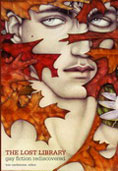 The Lost Library: Gay Fiction Rediscovered
The Lost Library: Gay Fiction Rediscovered
Edited by Tom Cardamone
Haiduk Press. 232 pages, $19.
TOM CARDAMONE invited 27 other gay authors to submit pieces about their “favorite out-of-print gay books or forgotten titles.” At the same time, he says in his introduction to the resulting anthology, he was looking for works of fiction that had been excluded from the “gay canon”: works that “embodied a diversity and history that was either pre-Stonewall or went far beyond the available urban story,” including “campy pulp paperbacks.” It was an admirable goal. I assume he is both exhilarated and somewhat disappointed by the outcome.
Jerry Rosco reaches back the furthest in time, offering an informative essay about Wescott’s 1924 novel, The Apple of the Eye. “With his use of lyrical prose and sensitive wordplay,” he writes, “Wescott takes the reader to the edge of forbidden territory for a mainstream writer of that time—sensual feelings, a wet dream, masturbation, and intercourse.” Michael Bronski tackles the most daring subject matter, resurrecting Kyle Onstott and Lance Horner’s 1966 erotic paperback Child of the Sun, about the Roman emperor Elagabalus. Bronski does not shrink from labeling this truly forgotten sexual fantasy “an important touchstone in a number of intersections of queer publishing currents.”
Although Samuel Steward’s $tud is listed in an appendix, no essayist looks at a one of the vast outpouring of gay pulps from West Coast porn houses that began appearing in the mid-1960’s as the Supreme Court loosened obscenity laws. Such totally forgotten hardback writers as Walter Baxter (Look Down in Mercy, 1951) and near-forgotten writers like Nial Kent (The Divided Path, 1949) and Lonnie Coleman (Ship’s Company, 1955, and Sam, 1959) do not even make this appendix.
As a result of reading Cardamone’s collection, I searched out a novel I had previously paid no attention to (Windham’s Two People) and bought two more than had not formerly registered for me (Benderson’s User and Paul T. Rogers’s Saul’s Book). I suspect other readers will find themselves similarly motivated. Most of the essays pack a lot of information both about the essayist’s own life and about the book under investigation. While I boned up for interviewing Roger Peyrefitte decades ago for Gay Sunshine, Gregory Woods’ discussion of The Exile of Capri includes all kinds of stuff I was unaware of.
But ultimately, I think, the value of this collection is not so much its stated aim to recover lost works as to provoke a conversation, which is what the book’s editor admits to being about: “I wanted to hear what books mattered, from writers I liked and knew or wanted to know.” For me, the more expository essays, the ones your English teacher would have favored, are not nearly as rewarding as those in which the essayist shows the intersection between the novel and his own life.
Some of the essays are so personal as to reveal little about the novel is question. I’d put Philip Clark’s almost painful identification with the characters in Bartlett’s Ready to Catch Him Should He Fall into that category. But in reading Larry Duplechan’s very mixed reactions to the African-American detective Pharaoh Love in George Baxt’s A Queer Kind of Death, I gained some insight into what it meant to be an “18-year-old black gay boy” in the early 1970’s.
The personal and the literary are nicely balanced in a few other essays: Sean Meriwether’s account of how Lynn Hall’s Sticks and Stones aided his own coming out process; Jesse Monteagudo’s political identification with the hero of Daniel Curzon’s Something You Do in the Dark; and Ian Rafael Titus’ connection with place in Dixon’s Vanishing Rooms. Meriwether wonders whether such intense feelings of identity are possible any longer, lamenting: “Literature plays such a minor role in our community now, when it used to be the primary means of uniting and informing our community.”
In a bonus essay, Phillip Clark provides an illuminating history of the reprinting of gay novels. The book also includes a brief bibliography and a list of other works of fiction that might be of interest. The essays themselves are arranged alphabetically by author. In addition, a chronological list is supplied, and the essayists are listed alphabetically in the contributors’ notes.
I wish that each contributor’s birth year had also been provided, as I suspect that the definition of a “lost” book depends on the era in which one first encountered gay fiction. If, as I suspect, the majority of the essayists were born from the late 50’s through the mid-70’s, that would explain why so many of the novels chosen were published in the 80’s and 90’s. I notice that most of the essays that I have singled out for mention above concern books that were published during my youth.
Drewey Wayne Gunn, professor emeritus of Texas A&M University-Kingsville, edited The Golden Age of Gay Fiction.





